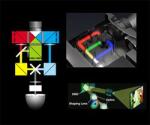
Available Sizes: 42"- 82"
Advantages:
Sharp image quality - LCD Rear-Projection TVs are razor sharp from corner to corner.
Weight - Except for the largest sizes, microdisplays can be easily lifted by two people.
Brightness - These TVs remain easy to see in the brightest viewing conditions.
Disdvantages:
Stands - Nearly all are table-top models, which require a stand to put them on.
Black level - Microdisplays still make black look more like a dark gray.
Price - While they're affordable compared to flat panel, they remain expensive compared to CRT rear-projection.
Microdisplay TVs work differently than traditional CRT based rear-projection sets. Rather than using three large CRT tubes, they use smaller fixed-pixel technologies powered by a very bright light bulb. A fixed-pixel technology differs from traditional displays because there is no electronic scanning to create the lines of an image. All the pixels in the display are predefined and addressed, so the resolution of the image is considered to be "fixed".
Microdisplays have a very bright and sharp picture that remains focused at every point on the screen. The extra brightness can be handy if you view your TV in sun-filled rooms. Color fidelity is usually good on a microdisplay, but can suffer a bit compared to traditional technologies.
Microdisplays reign king when it comes to retaining image quality. Traditional technologies will undoubtedly fade a bit as the hours accumulate, but microdisplays will continue to provide like-new picture quality for as long as you own it. And, unlike traditional tube based sets, they require no periodic convergence adjustments, so they will require less tinkering over the years.
For every up there's a down, and microdisplays have a big one that is played down by the manufacturers and salesmen who push them. As mentioned above, microdisplays use a high-intensity lamp as the light source. These lamps are no different from every other lamp in the sense that they have a limited life span. Once they're dead it costs anywhere between $200 and $400 for a new one. Manufacturers claim that they should last 4,000 to 8,000 hours, but many users are finding that those claims are often based on theory instead of reality.
If you've narrowed it down to a microdisplay, the next step is to figure out what kind of microdisplay you want to have. There's LCD, DLP, LCoS, and more. While each fixed-pixel technology provides a similar experience, there are a few differences you'll need to keep in mind before choosing which one to put in your living room.
Click on the links below to learn more about the different kinds of Microdisplay rear-projection TVs.
Return to Understanding the Different Types of TV




